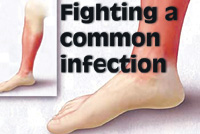
Fighting a common infectionSkin infections are one of the commonest conditions encountered at the surgical casualty. Here Dr. Nalitha Wijesundera, Consultant Surgeon at Karapitiya Teaching Hospital, discusses the problem with Dr. Melanie Amarasooriya. Cellulitis and erysipelas are two of the common skin infections seen among patients. The other commonly encountered conditions are abscesses, infections of the hair follicles and infected sebaceous cysts. These can occur in any area of the skin but cellulitis and erysipelas are especially common in the leg. Cellulitis and erysipelas Both these conditions are caused by micro-organisms called bacteria. They enter the deeper layers of skin through a small breach of the surface. If the conditions are right they start multiplying leading to inflammation.
The skin will be red and warm over the infected area. You will notice the affected area extending if you do not treat it early. You may also get fever and sometimes the fever may be accompanied by chills and rigors and a general feeling of being unwell. Painful and enlarged lymph nodes that drain the site of infection will begin to appear in the area too. For instance, if you have cellulitis of the leg you may feel painful lumps in the groin, due to enlarged lymph nodes. "Cellulitis needs to be treated as early as possible to prevent complications," says Dr. Wijesundera. You can recover from mild cellulitis quite easily, if your immune system is good. However if you have diabetes, especially if it is not under control, or if you are on steroid medications, the chances of the infection spreading, unless treated promptly, are high, he says. What are the possible complications that could arise?
Early or mild cellulitis only needs a course of oral antibiotics as treatment. But once the disease is advanced, the patient needs to be in hospital and antibiotics will have to be injected into the vein. Cellulitis is mostly common among diabetics when compared to other people. Optimum control over blood sugar levels is essential for prevention as well as for cure. It is up to the patient therefore to maintain good control over his/her diet. Sometimes it would be necessary to modify the medication taken for diabetes. Elevating the affected area helps to drain the excess fluid. But, most patients are happy just to keep their foot on a small stool. This does not actually serve the purpose. "For elevation to be of any use, the foot should be above the hip level so that excess fluid can be drained," explains Dr. Wijesundera. At the same time, you need to wiggle your toes from time to time to help circulation. Walking a few yards, too would help this. Other than these, painkillers like paracetamol will be given for the pain and fever. If there are underlying condition predisposing to cellulitis, like fungal infections or eczema they need to be treated first. There are also symptoms that may indicate that you are suffering from something more than Cellulitis. They are:
These symptoms indicate a more complicated pathology and would need immediate diagnosis and treatment. |
|
||||||
|| Front
Page | News | Editorial | Columns | Sports | Plus | Financial
Times | International | Mirror | TV
Times | Funday
Times | Medi Scene || |
| |
Reproduction of articles permitted when used without any alterations to contents and a link to the source page.
|
© Copyright
2008 | Wijeya
Newspapers Ltd.Colombo. Sri Lanka. All Rights Reserved. |
